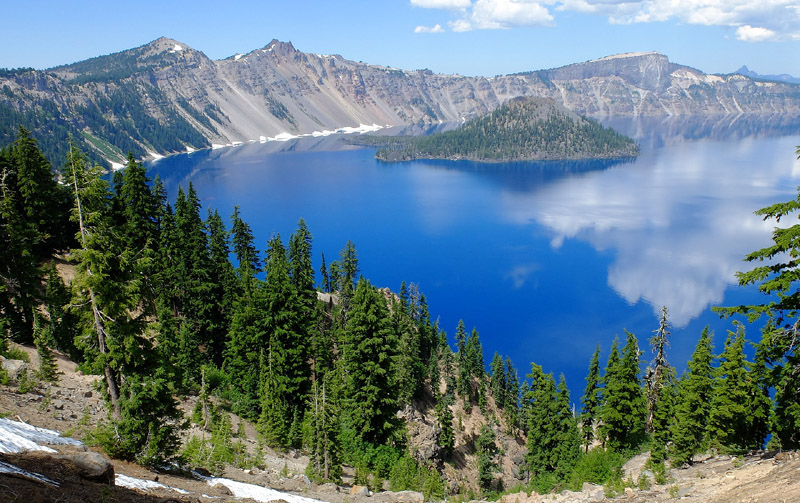
Tucked away in the southern Cascade Mountains in blue state Oregon is Crater Lake National Park. Established in 1902, the park oversees the deepest lake in the United States, with a maximum depth of more than 1,900 feet. But that’s only one of several notable features of this 21-square-mile Oregon splendor. Along with its six-mile diameter, Crater Lake showcases steep volcanic cliffs made from contorted lava, rising 2,000 feet in some areas.
On a sunny day, the lake’s waters vary from a light turquoise near the shore to a sapphire blue in the deeper parts. And although winter dresses the caldera rim of Crater Lake with an average snowfall of 45 feet, the lake seldom freezes over. In fact, 1949 is the last year on record to witness a frozen lake. The lake’s resilience to freezing over is primarily due to its massive volume. This acts as a thermal sponge absorbing and trapping solar heat to maintain water temperatures.
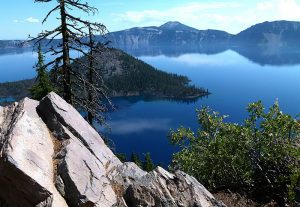 As an added distinction, Crater Lake has no underground tributaries feeding its pure, pristine waters. The lake rejuvenates through direct rain and snow precipitation and seasonal snow melts. Overall, much of Crater Lake’s uniqueness is attributable to basic geography, namely elevation and climate. Most visitors frequent the park from July through mid-September when the temperatures are relatively mild and precipitation is minimal. That’s also when the park’s roads, trails, and facilities tend to be fully operational.
As an added distinction, Crater Lake has no underground tributaries feeding its pure, pristine waters. The lake rejuvenates through direct rain and snow precipitation and seasonal snow melts. Overall, much of Crater Lake’s uniqueness is attributable to basic geography, namely elevation and climate. Most visitors frequent the park from July through mid-September when the temperatures are relatively mild and precipitation is minimal. That’s also when the park’s roads, trails, and facilities tend to be fully operational.
Nevertheless, the park’s higher altitudes may cause weather conditions to change quickly at any time. The park headquarters has an elevation of 6,500 feet; Rim Village is even higher at 7,100 feet. From October through June, when the park has limited road accessibility, preparing for extreme winter conditions is necessary.
Crater Lake’s Volcanic Past and Present
Crater Lake’s origin has its foothold in a past geologic formation — Mount Mazama, with an elevation that once exceeded 14,400 feet. About 7,700 years ago, a tremendous volcano erupted from within Mazama, with greater severity than the Mount St. Helens eruption in 1980. Some believe the eruption may be the largest in North America in the past 640,000 years. Losing much of its mass through the volcanic blast, Mazama’s peak collapsed into a 4,000-foot abyss six miles wide. This was the beginning of Crater Lake.
As geothermal activity continued and sealed the floor of the caldera, lesser volcanic cones arose. But they were eventually submerged by precipitation slowly creating a lake. One of those cinder cones, however, permeated the crater depths and is visible today near the southwest shore — the picturesque Wizard Island. A climb up the rugged sides of this cinder cone to Wizard Summit is rewarded by a glimpse into a miniature crater!
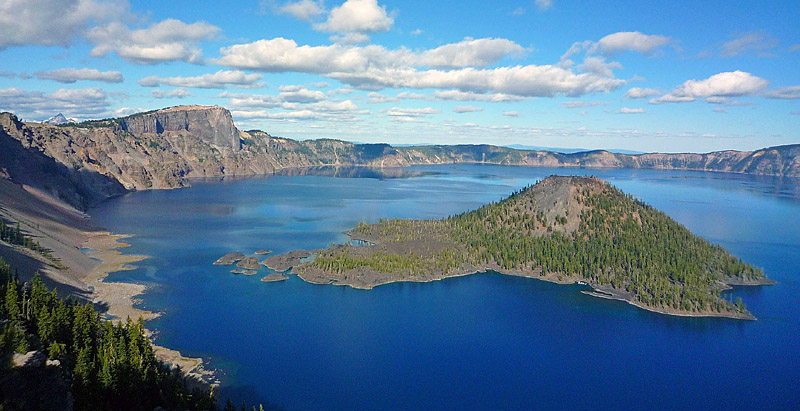
Still, a more mysterious site docked at Crater Lake is the Phantom Ship, a curiously carved island of lava as tall as a 16-story building. At a distance from the Phantom Ship Overlook or Sun Notch, the island’s outline suggests a ship under full sail. At sundown or by moonlight, the illusion is striking, but under some variances of light, this Phantom Ship strangely and suddenly disappears. Erosion-resistant lava, 400,000 years old, is the key geologic element of this island.
Among other natural features in Crater Lake National Park are The Pinnacles. These 200-to-300-feet-thick colorful volcanic spires rise 100 feet high or more and were formed during the same volcanic eruption that gave birth to the lake. Briefly described, these formations are fossilized pipes known as “fumaroles,” which initially vented volcanic ash and pumice particulates. As the hot volcanic gases rose upward, they eventually fused the layers of particulates, creating solid rock. Time and erosion later removed most of the extraneous volcanic deposits, leaving the towering pinnacles in full view.
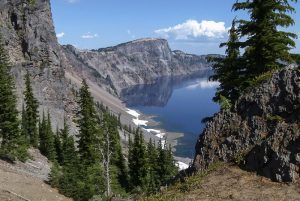 Discovering Crater Lake National Park
Discovering Crater Lake National Park
Crater Lake National Park is in southwestern Oregon, just northeast of Medford (77 miles) and northwest of Klamath Falls (57 miles). Finding the park site is relatively easy via State Rt. 62 from Medford or U.S. Highway 97 out of Klamath Falls, which then connects to State Rt. 62. Most visitors enter Crater Lake at the Annie Spring Entrance Station, adjacent to nearby Mazama Village. The latter provides a full range of facilities and services — restaurant food, lodging, fuel, camping, groceries, showers, and laundry.
Not far from Mazama Village are the park headquarters and the Steel Visitor Center, which are also open year-round. There you can ask questions of the rangers and watch a 22-minute film highlighting the park’s significance and examining the lake’s volcanic past. Then, just a few miles north on the service road, you’ll arrive at Rim Village. This facility is open from late May to late September. The village hosts several popular attractions: Rim Visitor Center, along with the Sinnott Memorial Overlook, and Crater Lake Lodge.
Sinnott Memorial is an attractive stone building constructed on Victor Rock along Crater Lake’s rim. This facility affords breathtaking panoramic views, along with exhibits to assist visitors in understanding the lake’s geologic and scientific history. Other educational offerings include self-guiding nature trails on which flora and places of geologic interest are carefully labeled. The park has more than 90 miles of hiking and backpacking trails. However, in May and June they are typically covered by deep snow. When snow-covered, most trails are either too difficult to follow or too dangerous. Additionally, park naturalists provide guided hiking field trips and escorted auto caravans throughout most of the park sites, weather permitting.
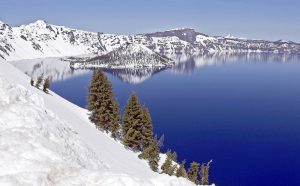 Rim Drive a Must-Do Experience
Rim Drive a Must-Do Experience
Although you can view all of Crater Lake from Rim Village on a clear day, undoubtedly, the not-to-be-missed experience is the two-to-three-hour drive around the lake. Rim Drive is a 33-mile road encircling the lake, with more than 30 scenic overlooks offering dramatic park views. As a reminder, parts of Rim Drive are closed seasonally due to snow. The park’s North Entrance Road and Rim Drive close for the season on November 1 (or earlier, if there is significant snowfall). Then they reopen between mid-May and late June. The East Rim opens between mid-June and late July; Rt. 62 and the road to Rim Village are open year-round.
Aside from The Pinnacles and Phantom Ship sites, park officials suggest several other must-see sites accessible via the Rim Drive. The first is Discovery Point. This is where lost gold prospector John Hillman on the back of a mule in 1853 unknowingly found what he called the “Deep Blue Lake.” Reportedly, he is the first European-American to set foot on the lake’s steep terrain.
The next stop, Watchman Overlook, gives park visitors an unrivaled view of Wizard Island. To find this unmarked site, you drive about four miles west of Rim Village and look for a viewpoint lined with wooden fences. The Watchman Peak Trail also begins at this location. Less than a mile long, the steady uphill trail reveals several nearby landmarks at the summit. Those of interest include Mount McLoughlin, Mount Thielsen, Union Peak, Mount Scott, and Klamath Basin.
Finally, the Pumice Castle Overlook exhibits one of the park’s most colorful features — a layer of orange pumice rock eroded into the shape of a medieval castle. Watch carefully for this unmarked viewpoint. It is located about one mile west of the Cloudcap Overlook junction, just over two miles east of the Phantom Ship Overlook.
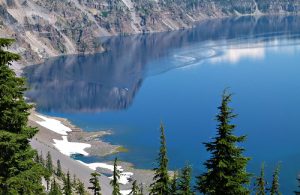 Crater Lake Recreational Activities
Crater Lake Recreational Activities
Like other traditional parks, Crater Lake National Park offers comparable recreational activities, such as cycling, fishing, skiing, sledding, snowshoeing, and swimming. However, there is only one legal access to the lake shoreline, the Cleetwood Cove Trail. It originates on the north side of the lake. The steep trail is just over a mile long and is not accessible for those with mobility impairment. Moreover, the short trek is recommended only for those in good physical condition. Depending on snow conditions, the trail is usually open from mid-June to late October. At the shoreline is a dock with concessionaire boats. These are for lake tours with scheduled stops at Wizard Island for dropping off and picking up passengers. Standard lake tours are two hours long; Wizard Island tours or stays range from five to six hours.
Of course, if further sight-seeing is what you desire, there is more! Situated between park headquarters and the Phantom Ship Overlook on East Rim Drive is Vidae Falls. This spring-fed cascading waterfall tumbles over a glacier-carved cliff, dropping 100 feet over a series of ledges. A little further east on Pinnacles Road (off Rim Drive) is Plaikni Falls. It’s just over a mile, southeast from the Phantom Ship Overlook. This site rests among an old-growth forest laden with flora; the park itself has more than 600 different plant species.
Abutting the North Entrance Road is the Pumice Desert Research Natural Area, the park’s largest RNA. And you don’t even have to hike to see this 2,950-acre research project! It is a prime example of a subalpine pumice field — a treeless plain that has yet to recover from Mount Mazama’s eruption. The terrain is about 200 feet thick and is the subject of ongoing study of plant succession and adaptation. Only 15 plant species can tolerate the Pumice Desert’s infertile soil, short growing season, and temperature extremes.
Additional Sight-Seeing Wonders and Park Fees
Other notable Crater Lake National Park sites and hiking trails are:
- Annie Creek Trail
- Castle Crest Trail
- Crater Peak
- Fumarole Bay
- Garfield Peak
- Godfrey Glen Trail
- Lady of the Woods Trail
- Lightning Springs Trail
- Llao Rock
- Pacific Crest National Scenic Trail
- Sun Notch Trail
- Timber Crater
From May through October, the park’s entrance fee is $25 per vehicle ($15 per motorcycle). The entrance pass is good for seven days. The rate is higher for commercial vehicles and subject to change. Cash, checks, and credit cards are all accepted. The room rates at the Crater Lake Lodge begin at $190 per night. When planning, consider advance reservations. The cabin rates at Mazama Village are $154 per night.
Standard Crater Lake boat tours cost $42 for adults (age 13 and up); $28 for children (age 3 to 12). Wizard Island tours cost $57 for adults; $36 for children. The Wizard Island shuttle costs $32 for adults; $20 for children. Rim Drive trolley tours cost $27 for adults (age 14 to 59); $24 for seniors (age 60 and up); $17 for children (age 6 to 13); and free for children under age 6.
For further information regarding other scenic destinations in Oregon, Washington, and the Pacific Northwest, visit here.